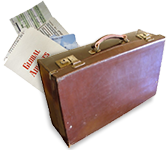As the economy recovers, so does travel volume. As you gird yourself to wade into the crowds, here are 10 tips to keep you moving over the river and through the woods…
- Expand Your Fly-vs.-Drive Tipping Point — My normal tipping point is 350 miles; anything less and I drive it. However, the holiday traffic changes the calculus a bit. If you fly, figure the airport logistics will add 3 hours to your in-flight time. Airlines are recommending passengers arrive 2 hours before their holiday flights, and when you arrive, all the additional people means it’ll take you at least an hour to de-plane, collect your luggage, and get off the airport property. And that’s if there are no delays. This increases the holiday fly-vs.-drive tipping point to at least 500 miles.
- Use Multiple Navigation Apps — If you decide to drive, use more than one maps app to help you route around traffic jams from rush hour, construction, and accidents. I personally use both Waze and Google Maps because, even though they’re both owned by Google, they often give you different directions. I find Waze is better at redirecting you around accidents and traffic jams, but can be a bit twitchy — sending you wandering through sub-divisions to save a minute of drive time. I tend to follow Waze but periodically check it against Google Maps.
- Sign Up for TSA PreCheck — Gift yourself and spend the $85 on some time and hassle reduction. You won’t get it in time for this Christmas, but it’s good for 5 years, so you’ll have it next Christmas.
- Apply for an Airline Credit Card — If your credit is good enough for instant approval, getting your airline’s credit card will get you entry level frequent flier status. This allows you to use the status security lines (handy if you don’t have PreCheck) and the second boarding group which is usually good enough to let you find some overhead bin space. This typically will work for you and your family. If the lead adult’s boarding pass shows priority/premiere access, the overworked minimum-wage airport staffers guarding the status security lanes will let the family tag along. And at the gate, I’ve never seen a family split across boarding groups.
- Fly Non-Stop — Holiday travel stacks up problems — high passenger load factors combined with winter weather disruptions almost guarantees late arrivals and missed connections. Even if you’re connecting through Houston, an intermediate stop adds one more point of failure, one more opportunity for the airlines to screw up. Pay the extra $100 for a non-stop flight.
- Skip the Tight Connection — If you can’t fly direct, step away from any connection that’s less than 60 minutes. Yes, we usually want to get to our destination in the shortest possible time, but accepting a connection of 1 hour or less…. Think about it – a 15-minute delay on your flight into a big hub like Chicago or Denver or Detroit (as good as on-time in the winter for most airlines) and you’re sprinting across terminals and concourses just to beat the closing door. A 1-hr connection is just asking for a stress attack and/or an overnight stay at the airport branch of the Bates Motel.
- Research Before You Leave — You don’t have time to be clueless. Hit the TSA website or the @AskTSA gang on Twitter so you know what’s allowed in your carry-on. Research the airports you’ll be using so you know how to your gates, where the good restaurants are, or better yet, if there’s a brewpub. Also, figure out the geography. Knowing alternatives to your destination airport gives you more flexibility dealing with cancelled flights or missed connections. In New York, the LaGuardia-to-Newark pivot is easy, but others aren’t so obvious. Everyone knows that Chicago has two airports – O’Hare and Midway. But what about Milwaukee’s Mitchell Field 80 miles north? If Philadelphia is in trouble, how many folks think about Harrisburg or BWI? Or Sacramento as an alternative to SFO?
- Catch the Early Flight — Delays stack up as the day wears on. As your airplane goes from airport to airport, the probability of it getting stuck increases. Overnight, airlines have a chance to recover – late planes finally get their destinations and operations groups can reassign planes. So while the last flight out can be a crap shoot, I rarely hit a delay on the first flight out.
- Use Multiple Flight Tracking Apps — Use your smartphone to keep track of gate changes and flight delays. Sign up for text notifications from your airline when you book your ticket. However, I’ve often experienced long delays with the airlines’ services or notices that were never sent out. So I also use TripIt, FlightAware, and FlightStats. It means multiple notices, but it also means I don’t miss anything.
- Use Twitter as a Concierge Service — Most airlines have social media teams monitoring Twitter. Before you leave, find and follow your airline’s Twitter customer service account. “At naming” them in a Tweet (e.g., “@united what’s happening with UA 4286 MSY-ORD that it’s 1:45 hr delayed?”) usually gets a response in a couple of minutes. Following them allows you to exchange personal information such as record locator numbers via direct message (DM). It’s usually faster than queuing up for a frazzled gate agent and the results can be better.
But above all, be realistic. It’s gonna be a zoo. Steel yourself; get your inner karma tuned for it. Pack a snack and a book, and practice deep cleansing breaths.

